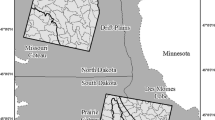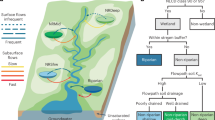Abstract
Although recent U.S. Supreme Court rulings indicate surface hydrologic connectivity (SHC) between geographically isolated wetlands and nearby streams may be used, in part, to determine wetland jurisdictional status, and ecologic implications are considerable regardless of policies, wetland–stream SHC has rarely been quantified. Furthermore, the impact of cultivation and restoration on wetland–stream SHC is largely unknown. To help fill these knowledge gaps, we recorded SHC patterns during water year 2010 in non-perennial streams connecting Delmarva bay wetlands, which are commonly considered geographically isolated, and nearby perennial streams. We also evaluated how hydrologic wetland restoration impacts SHC relative to historical wetlands and native forested wetlands. Cumulative connection duration, number of connectivity transitions, mean connection duration, and maximum individual connection duration (D max-c ) were quantified. Forested wetlands were connected to perennial streams for a greater cumulative duration but exhibited fewer connectivity transitions relative to both historical and restored wetlands. SHC between historical and restored wetlands and nearby perennial streams did not differ with respect to any of the calculated metrics. Forested wetland-stream SHC was seasonally intermittent, exhibiting stream outflow from mid-fall to late-spring during periods of low evapotranspiration and elevated groundwater levels but lacking connectivity during summer months when evapotranspiration and groundwater were at an annual high and low, respectively. Historical and restored wetland-stream SHC was largely ephemeral, occurring in response to antecedent rainfall, particularly during winter and spring. Stepwise regression models describe cumulative connection duration and D max-c as a function of wetland, watershed, and non-perennial stream metrics including watershed relief, non-perennial stream slope, non-perennial stream length, and soil saturated hydraulic conductivity. Wetland–stream SHC has potential ecological implications, including provision of dispersal corridors for biota, biogeochemical processing of nutrients, and downstream delivery of energy, matter, and organisms, and is currently tied to wetland regulatory status in the U.S.







Similar content being viewed by others
References
Babbitt KJ, Tanner GW (2000) Use of temporary wetlands by anurans in a hydrologically modified landscape. Wetlands 20:313–322
Bennett SH, Nelson JB (1991) Distribution and status of Carolina bays in South Carolina. South Carolina Wildlife and Marine Resources Department. Nongame and Heritage Trust Publication No. 1, Columbia
Braekke FH (1999) Drainage, liming and fertilization of organic soils. I. Long-term effects on acid/base relations. Scand J For Res 14:51–63
Caruso BS, Haynes J (2011) Biophysical-regulatory classification and profiling of streams across management units and ecoregions. J Am Water Resour Assoc 47:386–407
Comer P, Goodin K, Tomaino A, Hammerson G, Kittel G, Menard S, Nordman C, Pyne M, Reid M, Sneddon L, Snow K (2005) Biodiversity Values of Geographically Isolated Wetlands in the United States. Nature Serve, Arlington
Dahl TE (1990) Wetland losses in the United States 1780s to 1980s. U.S. Department of the Interior Fish and Wildlife Service, Washington
Dodds WK, Gido K, Whiles MR, Fritz KM, Matthews WJ (2004) Life on the edge: the ecology of great plains prairie streams. Biosci 54:205–216
Downing DM, Winer C, Wood LD (2003) Navigating through clean water act jurisdiction: a legal review. Wetlands 23(3):475–493
Dunne T, Leopold LB (1978) Water in Environmental Planning. W.H. Freeman Co., San Francisco
Fenstermacher DE, Rabenhorst MC, Lang MW, McCarty GW, Needelman BA (2014) Distribution, morphometry, and land use of Delmarva bays. Wetlands
Fisher TR, Benitze JA, Lee K-Y, Sutton AJ (2006) History of land cover change and biogeochemical impacts in the choptank river basin in the mid-Atlantic region of the US. Int J Remote Sens 27:3683–3703
Fisher TR, Jordan TE, Staver KW, Gustafson AB, Koskelo AI, Fox RJ, Sutton AJ, Kana T, Beckert KA, Stone JP, McCarty G, Lang MW (2010) The Choptank basin in transition: intensifying agriculture, slow urbanization, and estuarine eutrophication. In: MJ Kennish and HW Paerl (eds) Coastal Lagoons: Systems of Natural and Anthropogenic Change. CRC Press, pp 135–165
Fritz KM, Johnson BR, Walters DM (2006) Field Operations Manual for Assessing the Hydrologic Permanence and Ecological Condition of Headwater Streams. EPA/600/ R-06/126. U.S. Environmental Protection Agency, Office of Research and Development, Washington
Fry J, Xian G, Jin S, Dewitz J, Homer C, Yang L, Barnes C, Herold N, Wickham J (2011) Completion of the 2006 national land cover database for the conterminous united states. Photogramm Eng Remote Sens 77(9):858–864
Galatowitsch SM, van der Valk AG (1996) Vegetation and environmental conditions in recently restored wetlands in the prairie pothole region of the USA. Vegetatio 126:89–99
Gibbons JW (2003) Terrestrial habitat: a vital component for herpetofauna of isolated wetlands. Wetlands 23:630–635
Golden HE, Lane CR, Amatya DM, Bandilla KW, Rannan Kiperwas H, Knightes CD, Ssegane H (2014) Hydrologic connectivity between geographically isolated wetlands and surface water systems: a review of select modeling methods. Environ Model Softw 53:190–206
Gordon ND, McMahon TA, Finlayson BL, Gippel CJ, Nathan RJ (2004) Stream hydrology: an introduction for ecologists. Wiley, Chichester
Hamon WR (1963) Computation of direct runoff amounts from storm rainfall. Intl Assoc Scientific Hydrol Publ 63:52–62
Hermoso V, Ward DP, Kennard MJ (2012) Using water residency time to enhance spatiotemporal connectivity for conservation planning in seasonally dynamic freshwater ecosystems. J Appl Ecol 49:1028–1035
Lane CR, D’Amico E, Autrey B (2012) Isolated wetlands in the Southeastern United States: abundance and expected condition. Wetlands 32(4):753–767
Lang MW, McDonough OT, McCarty GW, Oesterling R, Wilen BO (2012) Enhanced detection of wetland–stream connectivity using LiDAR. Wetlands 32:461–473
Lang MW, McCarty GW, Oesterling R, Yeo I-Y (2013) Topographic metrics for improved mapping of forested wetlands. Wetlands 33:141–155
Leibowitz SG (2003) Isolated wetlands and their functions: an ecological perspective. Wetlands 23(3):517–531
Leibowitz SG, Nadeau T-L (2003) Isolated wetlands: state-of-the-science and future directions. Wetlands 23:663–684
Leibowitz SG, Wigington PJ, Rains MC, Downing DM (2008) Non-navigable streams and adjacent wetlands: addressing science needs following the supreme court’s rapanos decision. Front Ecol Environ 6:366–373
Martin DB, Hartman VA (1987) The effect of cultivation on sediment composition and deposition in prairie pothole wetlands. Water Air Soil Pollut 34:45–53
McAvoy WA, Bowman P (2002) The flora of coastal plain pond herbaceous communities on the Delmarva peninsula. J Phila Bot Club Bartonia 61:81–91
Min J-H, Perkins DB, Jawitz JW (2010) Wetland-groundwater interactions in subtropical depressional wetlands. Wetlands 30:997–1006
Mitsch WJ, Gosselink JG (2000) Wetlands, 3rd edn. Wiley, New York
Nessel JK, Bayley SE (1984) Distribution and dynamics of organic matter and phosphorus in a sewage enriched cypress swamp. In: Ewel KC, Odum HT (eds) Cypress Swamps. University Presses of Florida, Gainesville, pp 262–278
Phillips PJ, Shedlock RJ (1993) Hydrology and chemistry of groundwater and seasonal ponds in the Atlantic coastal plain in Delaware, USA. J Hydrol 141:157–178
Poff NL, Allan JD, Bain MB, Karr JR, Prestegaard KL, Richter BD, Sparks RE, Stromberg JC (1997) The natural flow regime: a paradigm for river conservation and restoration. Biosci 47:769–784
Rains MC, Fogg GE, Harter T, Dahlgren RA, Williamson RJ (2006) The role of perched aquifers in hydrological connectivity and biogeochemical processes in vernal pool landscapes, Central Valley, California. Hydrol Process 20:1157–1175
Semlitsch RD, Bodie JR (1998) Are small, isolated wetlands expendable? Conserv Biol 12:1129–1133
Sharitz RR (2003) Carolina bay wetlands: unique habitats of the southeastern United States. Wetlands 23:550–562
Sharitz RR, Gresham CA (1998) Pocosins and Carolina bays. In: Messina MG, Conner WH (eds) Southern Forested Wetlands: Ecology and Management. Lewis Publishers, Boca Raton, pp 343–377
Sipple WA (1999) Days Afield. Published by the author, Millersville
Stolt MH, Rabenhorst MC (1987) Carolina bays on the eastern shore of Maryland: II. Distribution and origin. Soil Sci Soc Am J 51:399–405
Tiner RW (2003) Geographically isolated wetlands of the United States. Wetlands 23:494–516
Tiner RW, Burke DG (1995) Wetlands of Maryland. U.S. Fish and Wildlife Service, Ecological Services. Region 5, Hadley, MA and Maryland Department of Natural Resources Cooperative publication, Annapolis
Tiner RW, Bergquist HC, DeAlessio GP, Starr MJ (2002) Geographically Isolated Wetlands: a Preliminary Assessment of Their Characteristics and Status in Selected Areas of the United States. U.S. Department of the Interior Fish and Wildlife Service, Northeast Region, Hadley
Ullah S, Faulkner SP (2006) Denitrification potential of different land-use types in an agricultural watershed, lower Mississippi valley. Ecol Eng 28(2):131–140
United States Department of Agriculture Natural Resources Conservation Service (2009) Wetland Reserve Program Final Programmatic Environmental Assessment: http://www.nrcs.usda.gov/Internet/FSE_DOCUMENTS/nrcs143_006911.pdf
Whigham DF, Jordan TE (2003) Isolated wetlands and water quality. Wetlands 23:541–549
Wilcox BP, Dean DD, Jacob JS, Sipocz A (2011) Evidence of surface connectivity for Texas gulf coast depressional wetlands. Wetlands 31:451–458
Winter TC, LaBaugh JW (2003) Hydrologic considerations in defining isolated wetlands. Wetlands 23:532–540
Wise WR, Annable MD, Walser JAE, Switt RS, Shaw DTA (2000) A wetland-aquifer interaction test. J Hydrol 227:257–272
Yepsen M, Baldwin AH, Whigham DF, McFarland E, LaForgia M, Lang MW (2014) Agricultural wetland restorations on the USA Atlantic coastal plain achieve diverse native wetland plant communities but differ from natural wetlands. Agric Ecosyst Environ 197:11–20
Ylla I, Sanpera-Calbet I, Munoz I, Romani AM, Sabater S (2011) Organic matter characteristics in a Mediterranean stream through amino acid composition: changes driven by intermittency. Aquat Sci 73:523–535
Acknowledgments
Funding for this research came in part from the Wetland Component of the National United States Department of Agriculture (USDA) Conservation Effects Assessment Project (CEAP) and the University of Maryland College Park Behavior-Ecology-Evolution-Systematics (BEES) graduate program. We thank Danny Welch, Greg McCarty, Tom Fisher, Brian Laub, Tony Oesterling, Kristen Politano, Heather Chen, and Shelley Devereaux for their assistance in the field and lab. We are particularly grateful for the insightful comments provided by two anonymous reviewers.
Author information
Authors and Affiliations
Corresponding author
Rights and permissions
About this article
Cite this article
McDonough, O.T., Lang, M.W., Hosen, J.D. et al. Surface Hydrologic Connectivity Between Delmarva Bay Wetlands and Nearby Streams Along a Gradient of Agricultural Alteration. Wetlands 35, 41–53 (2015). https://doi.org/10.1007/s13157-014-0591-5
Received:
Accepted:
Published:
Issue Date:
DOI: https://doi.org/10.1007/s13157-014-0591-5




